Chinese Buddhism
This article shouldspecify the languageof its non-English content, using{{lang}},{{transliteration}}for transliterated languages, and{{IPA}}for phonetic transcriptions, with an appropriateISO 639 code.Wikipedia'smultilingual support templatesmay also be used.(February 2024) |
This articlemay requirecopy editingfor grammar, style, cohesion, tone, or spelling.(February 2024) |
| Part ofa serieson |
| Chinese Buddhism |
|---|
 |
| Chinese Buddhism | |||||||||||||||
|---|---|---|---|---|---|---|---|---|---|---|---|---|---|---|---|
| Traditional Chinese | Hán truyện phật giáo | ||||||||||||||
| |||||||||||||||
Chinese BuddhismorHan Buddhism(simplified Chinese:Hán truyện phật giáo;traditional Chinese:Hán truyện phật giáo;pinyin:Hànchuán Fójiào;Jyutping:Hon3 Cyun4 Fat6 Gaau3;Pe̍h-ōe-jī:Hàn-thoân Hu̍t-kàu) is a Chinese form ofMahayanaBuddhism which draws on theChinese Buddhist canon[1]that includes the indigenous cultural traditions of Confucianism and Taoism (Chinese: Tam giáo; pinyin: sān jiào) and the rituals of local colloquialisedfolk religions.Chinese Buddhism focuses on studyingMahayana sutrasand Mahāyāna treatises and draws its main doctrines from these sources. Some of the most important scriptures in Chinese Buddhism include:Lotus Sutra,Flower Ornament Sutra,Vimalakirtī Sutra,Nirvana Sutra,andAmitābha Sutra.[2][3]Chinese Buddhism is the largest institutionalized religion inmainland China.[4]Currently, there are an estimated 185 to 250 million Chinese Buddhists in thePeople's Republic of China.[4]It is also a major religion in Taiwan, Singapore, and Malaysia, as well as among theChinese Diaspora.[2]
Buddhism was first introduced to China during theHan dynasty(206 BCE – 220 CE). It was promoted by multipleemperors,especially during theTang dynasty(618–907), which helped it spread across the country.[5]The translation of a large body of Indian Buddhist scriptures into Chinese and the inclusion of these translations (along withTaoistandConfucianworks) into aChinese Buddhist canonhad far-reaching implications for the dissemination of Buddhism throughout theEast Asian cultural sphere,including Korea, Japan, and Vietnam. Chinese Buddhism also developed various unique traditions of Buddhist thought and practice, includingTiantai,Huayan,Chan Buddhism,andPure Land Buddhism.
From its inception, Chinese Buddhism has been influenced by nativeChinese religionsandphilosophy,especiallyConfucianismandTaoism,but alsoChinese folk religion.
History
[edit]

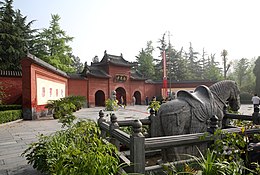



The establishment of Buddhism in China
[edit]Buddhist missionaries began bringing Buddhism toChinaduring theHan dynasty(206 BCE-220 CE) and the religion was present in China at the beginning of the common era.[7][2][8]
Buddhist missionaries made use of both the overland Central AsianSilk Roadand themaritimeroutes.[9]Initially Buddhism was poorly understood and often confused with and mixed with Taoism.[10]The Chinese saw many similarities between the two religions.[11]There was also much criticism leveled at the new foreign religion by theConfucianelites.[2]
One of the central tasks of the initial missionaries was the translation of Buddhist texts. The first surviving translations ofBuddhist textsinto Chinese were those of the 2nd centuryParthianAn Shigao(Ch.An thế cao), who worked in the capital ofLuoyang.His work was followed by the extensiveMahayanatranslations of theKushanmonkLokakṣema(Ch.Chi lâu già sấm,activec. 164–186 CE), as well as the work ofDharmarakṣa(3rd century).[12][13]
During this early period, theDharmaguptakaschool was very influential in establishing Buddhism in China.[14]This resulted in the widespread adoption of the Dharmaguptaka school'sVinaya(monastic rule) by all Chinese Buddhist schools.
The arrival of theKuchanscholarKumārajīva(334–413 CE) was a key event. Unlike the previous translators, Kumārajīva was supported by the state and given the title of national preceptor.[15]The numerous high quality translations of his translation team had a great impact on Chinese Buddhism. He is also known for introducing theMadhyamakaschool of Buddhist philosophy, which would later be calledSanlun(the "Three Treatise school" ).[16]His work also established a thoroughly Indic foundation for Chinese Buddhist philosophy, which previously had been heavily influenced by Taoist philosophy.[17]
By the 460s Buddhism was a mainstream institution in China, and its iconography and art were widely recognized.[18]The Dunhuang andYungangcave complexes are a great example of early Chinese Buddhist art from this period.[19]
Another important translator wasParamārtha(Zhēndì,499–569 CE) who along with his team of Chinese disciples translated numerous works onAbhidharma,Yogacharaphilosophy, and other Mahayana texts.[20][21]The work of other sixth century translators likeBodhiruciand Ratnamati also contributed to the establishment of a newChinese Yogacara school,also known as the "Consciousness-Only school" ( duy thức tông; pinyin: Wéishí-zōng).
The development of a Chinese Buddhism
[edit]The 6th and 7th centuries saw a flowering of new and unique Chinese Buddhist traditions, including:
- TheTiantaischool mainly founded by the efforts of masterZhiyi(538–597 CE) and based on theLotus Sutraand works of Zhiyi.
- TheHuayan(Avatamsaka Sutra) school, based on the works of Chinese masters likeDushun(557–640),Zhiyan(602–668), andFazang(643–712).
- ThePure Land tradition,which is based on the veneration ofAmitabhaand the works of Pure Land masters likeTanluan(476–542),Daochuo(562–645), andShandao(613–81).
- Chan Buddhism,based on the teachings of various Chan masters such asBodhidharma,Dazu Huike(487–593),Sengcan(d. 606),Dayi Daoxin(580–651), andHongren(601–674).
During the Tang dynasty, the monkXuanzang(602–664) journeyed to India and back and wrote extensive and detailed reports of his findings, which have subsequently become important for the study of India during this period. Xuanzang also brought back many Buddhist texts and led a translation team which was responsible for many influential Chinese translations of classic Buddhist works.[22]His efforts led to the establishment of the idealistic Yogachara (Consciousness-only) tradition in East Asia.
The Tang era was one of the golden ages of Buddhism in China.[23]During this time, asinicizedBuddhism was widely accepted and practiced throughout the empire, with many monasteries and temples. Buddhism was popular with all social classes and was very influential on Chinese culture,[2]being more popular and having more followers than Taoism.[24]Buddhist themes can be found in much of the literature of this period, such as in the works of famous poets likeWang Wei(701–761) andBo Juyi(772 – 846). The various artistic complexes from this period, such as theLongmen Grottoes,also attest to the artistic vibrancy of Chinese Buddhism at this time.[2]
A famous proponent of Buddhism during the Tang era was empressWu Zetian(r. 690–705) and she is known for her promotion of theLongmen cave complex.[25][26]She also depicted herself as a bodhisattva.[27]
The next important event in the history of Chinese Buddhism was the arrival ofSubhakarasimha,Vajrabodhi,andAmoghavajra,and their establishment ofChinese Esoteric Buddhismfrom 716 to 720, during the reign ofEmperor Xuanzong of Tang.This Chinese form ofVajrayanaBuddhism now became popular with the elites and by the time ofEmperor Daizong of Tang(r. 762–779), its influence among the upper classes was significant.
TheGreat Anti-Buddhist Persecution(841–845) underEmperor Wuzong of Tanggreatly impacted and weakened the Buddhist institutions in China. Perhaps the main reason for this persecution was the Chinese state's need for tax and wealth.[28]
TheFive Dynasties and Ten Kingdoms period(907–960/979), an era of great political upheaval and civil war, also negatively impacted Chinese Buddhism. Various Chinese Buddhist traditions contracted or died out during this period.
TheSong dynasty(960–1279) saw the flourishing of Chinese Buddhist culture.[2]During the Song,Chan Buddhismgrew to become the most influential school, with close ties to the imperial government and a highly organized system of temple rank and administration system developed.[29]It was during this time that the classicFive Houses of Chandeveloped. Many classic Chan texts were written during this era, such as the famedkoancollections of theLinji school,like theBlue Cliff Record(1125) andThe Gateless Gate(1228).[30]
Likewise, during this time, the works ofHongzhi Zhengjue(1091–1157) developed the silent sitting method of "silent illumination".[31]Both of these traditions of Chan practice were very influential (and remain so) on East AsianZen Buddhism(including onJapanese Zen,Korean Seon,and VietnameseThiền).
TheYuan dynasty(1271–1368) patronizedTibetan Buddhismand thus, during this period there was a steady growth of this tradition in China.[32]A common perception was that this patronage of lamas caused corrupt forms of tantra to become widespread.[32]When the Yuan dynasty was overthrown and theMing dynastywas established, the Tibetan lamas were expelled from the court, and this form of Buddhism was denounced as not being an orthodox path.[32]
During theMing dynasty(1368–1644), there was a revival of the study of native Chinese traditions like Tiantai,Huayan,and Yogachara, and most monks belonged to the two dominant Chan schools:LinjiandCaodong.[33][34][35]At this point in its history, Chinese Buddhism had also become quite eclectic, drawing from all the main Chinese traditions. An example of this is the figure ofHanshan Deqing,one of the great reformers of Chinese Buddhism.[36]Like many of his contemporaries, he advocated the dual practice of the Chan and Pure Land methods.[36]He also directed practitioners in the use of mantras as well as scripture reading. He was also renowned as a lecturer and commentator and was admired for his strict adherence to the precepts.[36]
Modernity
[edit]
During theQing dynasty(1644–1911), the imperial court shifted its support to theGelug schoolof Tibetan Buddhism.[37]Chinese Buddhism suffered much during the various imperial and internal conflicts of the Qing dynasty, especially the devastatingTaiping rebellion(December 1850 – August 1864), which saw many temples destroyed and scriptures burned by rebels.[38]This era also saw the arrival ofChristian missionariesto China, a right which had been granted to Western powers after theOpium Wars.[37]
During theRepublican period(1912–1949), there were various attempts to reform and modernize Chinese Buddhism and to respond to the various challenges of modernity.[39][2]The most notable of these reformers were theHumanistic Buddhists,likeTaixuandYin Shun.Humanistic Buddhism sought to move away from ritualistic and otherworldly obsessions to embrace more worldly pursuits likeeducationandcharitablework.[2]There was also a revival ofChinese ChanbyHsu YunandSheng Yen,[39]as well as a revival of Tiantai Buddhism by Dixian andTanxu(1875 – 1963).[40]
People's Republic of China
[edit]After theChinese Communist Revolution,many Buddhists and monastics followed the Republican exodus toTaiwan.In the latter half of the twentieth century, many new Buddhist temples and organizations were set up by the exiles in Taiwan, includingFo Guang Shan,Dharma Drum Mountain,andTzu Chi.[2]These organizations also became influential back inMainland Chinaafter the end of theCultural Revolution.[citation needed]
Chinese Buddhism suffered extensive repression, persecution, and destruction during the Cultural Revolution (from 1966 untilMao Zedong's death in 1976).Maoistpropaganda depicted Buddhism as one of theFour Olds,as a superstitious instrument of the ruling class and ascounter-revolutionary.[41]Buddhist clergy were attacked, disrobed, arrested, and sent to camps. Buddhist writings were burned. Buddhist temples, monasteries, and art were systematically destroyed and Buddhist lay believers ceased any public displays of their religion.[41][42]
During the normalization period (Boluan Fanzheng,1977 to early 80s) led byDeng Xiaoping,a new revival of Chinese Buddhism began to take place.[43][44][45]This was a period which saw the restoration of damaged Buddhist temples likeGuoqing TempleandGuanghua Temple,as well as the return of monastic ordination and Buddhist institutions. Monks like Zhenchan ( chân thiền ) and Mengcan ( mộng tham ), who were trained in the Chan and Huayan traditions, traveled widely throughout China as well as other countries, such as the United States, and lectured on both Chan and Huayan teachings.[46]Monks are required to obtain certificates from the authorities that permit them to reside in monasteries.[47]: 190
TheBuddhist Association of Chinais the sole official government supervisory organ of Buddhism in the country.[48]It is directed by theUnited Front Work Departmentof theChinese Communist Party(CCP).[49]
| Part ofa serieson |
| Mahāyāna Buddhism |
|---|
 |
Teaching and practice
[edit]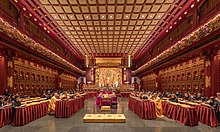
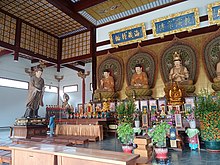

Doctrine and texts
[edit]Chinese Buddhism is asinicizedform ofMahāyāna Buddhism,which draws on theChinese Buddhist Canon( đại tàng kinh,Dàzàngjīng,"Great Storage of Scriptures" )[1]as well as numerous Chinese traditions. Chinese Buddhism focuses on studyingMahayana sutrasand Mahāyāna treatises and draws its main doctrines from these sources. Some of the most important scriptures in Chinese Buddhism include: theLotus Sutra,theFlower Ornament Sutra,theVimalakirtī Sutra,theNirvana Sutra,and theAmitābha Sutra.[2][50]
As such, Chinese Buddhism follows the classic Mahāyāna Buddhist worldview, which includes a belief in manyrealms of existence,the existence of manyBuddhasandbodhisattvas,as well as many other kinds of divine beings, ghosts, and so on.[2]Chinese Buddhism also upholds classic Mahayana Buddhist doctrines likekarma(Báo ứng) andrebirth(Siêu sinh), thebodhisattvapath, and the doctrines ofemptiness,buddha-nature,and theone vehicle.[2]
When it comes toBuddhist philosophy,Chinese Buddhism contains various doctrinal traditions, the most important being the Tiantai,Huayan,Sanlun,andWeishischools of thought.[2]These different doctrinal traditions developed their own scriptural commentaries and treatises and also various doctrinal classifications (panjiao), which hierarchically ordered the mass of Buddhist scriptures in order to advance their school'shermeneuticalworldview.[2]For example, according to master Zhiyi's "eight teachings and five periods" classification, the final and supreme teaching of the Buddha is found in theLotus Sutraand theNirvana Sutra.[2]According to the Huayan masters likeFazang,the Huayan sutra contains the supreme teaching, while the Weishi school held that the Yogachara texts are where the "third turning" of the Dharma can be found, and thus, represent the final and ultimate teaching of the Buddha.
Practices
[edit]
Chinese Buddhism contains a wide array of religious practices and observances. Ritual and devotional practices are commonly seen as generating karmicmerit,which can bring about positive results in this life or the next.[2]
According to Mario Poceski, for the vast majority of ordinary Chinese Buddhists, "prevalent expressions of Buddhist piety were (and still are) channeled via a variety of popular modes of worship and ritual observance."[2]Worship services can includeBuddhist devotionalpractices like offerings to an altar (of items like incense, flowers, food, and candles), ceremonial bowing, and extensive liturgies (including repentance ceremonies, rites for good health, and memorials for the dead).[2]According to Chün-fang Yü, the most popular Chinese Buddhist ritual that is most widely performed today is the Great Compassion Repentance associated withGuanyinand theGreat Compassion Dharani.[51]
Keeping sets of ethical rules, like the classic Buddhistfive precepts,are another key part of Buddhist practice. Taking up the ethical precepts in a ceremony, along with taking refuge in the three jewels (Buddha, Dharma, and Sangha), is a common way of entering the Buddhist path.[2]Another important set of ethical precepts is the "bodhisattva precepts"of theBrahmā's Net Sutra,which are often practiced by both laity and monastics.[2]Acts of charity or social service (Kết duyên) are also an important of part of ChineseBuddhist ethics.
Another key part of Chinese Buddhism is engaging inBuddhist meditationssuch as chanting the Buddha's name (nianfo), which is the core practice ofPure Land Buddhism,and seated meditation (zazen), which is the focus of theChantradition. The practice of recitation of the Buddha's name is commonly done in a group setting, sometimes as part of an intensive nianfo recitation retreat, which can last for several days. These retreats might also include chanting sutras, taking of theeight precepts,silent meditation, andDharma lectures.[52]
Textual practices are also commonly practiced by monks and laypersons. These include printing, copying, propagating and reciting Buddhist scriptures, studying Buddhist texts, and attending lectures.[53][54]Buddhist temples may also have special elements associated with sacred texts, such as lecture halls ordharma halls,libraries, and scripture platforms ( thi pháp đàn ), a kind of sacred podium.[53][54]
Other important Buddhist rituals are those related to death, which is seen as a key moment for Buddhists who want to attain a good rebirth in the pure land of a Buddha (the most popular being Amitabha's pure land).[52]The focus of these rituals is to keep the dying person free of distractions and offer spiritual support (so they can focus their minds on Amitabha Buddha through the repetition of the Buddha's name).[52]It is commonly believed that during these rituals one can experience auspicious signs, like visions of Amitabha and bright lights.[52]
Pilgrimagesto well-known monasteries and sites, like theFour Sacred Buddhist Mountains(Mount Wutai,Mount Emei,Mount Jiuhua,andMount Putuo) are also undertaken by monastics and lay practitioners alike.[55]
Another popular practice is the use of mantras anddhāraṇīs,such as the popularMahā Karuṇā Dhāraṇīand theCundī Dhāraṇī.[55]Robert Gimello has also observed that in Chinese Buddhist communities, the esoteric practices ofCundīenjoyed popularity among both the common people and the elite.[56]
Deities and temples
[edit]


Various MahāyānaBuddhist deitiesare venerated in Chinese Buddhism, most of which are Buddhas and bodhisattvas. Some of the key figures include:[57][2]
- Śākyamuni(Shijiamoni, "sage of theśākyas"), the historical founder of Buddhism, commonly depicted withᾹnandaandMahākāśyapa,or in a triad with Amitabha andMedicine Buddha.
- Avalokiteśvara,the bodhisattva of compassion who has various forms (such as the thousand arms form), the most popular being the motherlyGuānyīn.
- AmitābhaBuddha (pinyin:Ēmítuó fó, "Limitless Light" ), also called Amitāyus ( "Limitless Life" ), associated with thepure landofSukhavati,which many hope to reach after death
- Vairocana(Dàrì Rúlái), the cosmicprimordial Buddha
- Medicine Buddha(Yàoshī fó), associated with medicinal powers
- Maitreyabodhisattva (Mílè púsà), is seen as the Buddha of the future, sometimes depicted as afat laughing Buddha
- Manjushribodhisattva (Wénshū púsà), the bodhisattva of wisdom, associated withMount Wutai,often appears mounted on a lion.
- Samantabhadrabodhisattva (Pǔxián púsà), often depicted riding an elephant, is associated with confession and repentance rites and the bodhisattva vows.
- Kṣitigarbhabodhisattva (Dìzàng púsà), the savior monk associated with rites for the deceased
- TheEighteen Arhats(Shíbā Luóhàn)
- TheFour Great Heavenly Kings(Sìdà Tiānwáng)
- TheTwenty-Four Protective Deities(Chinese:Nhị thập tứ chư thiên;pinyin:Èrshísì Zhūtiān), a common ser ot Chinese Buddhist protector deities (dharmapalas).
Chinese Buddhist temples usually include numerous images and statues of Buddhas and bodhisattvas. They are often ritually carved and installed as part of a consecration ritual that may include chanting and scripture reading.[58]Devotion towards these are a major part of Chinese Buddhism. As Chün-fang Yü writes, "people in China worship Buddhas and bodhisattvas in rituals, write poems and novels about them, praise them in songs and hymns, and tell stories and stage plays about them. And above all else, they worship the images of these holy beings."[59]
According to Mario Poceski, Chinese Buddhist temples generally follow a traditionalChinese palacelayout. They "consist of a series of halls and courtyards that are arranged symmetrically around a central axis, which usually runs from north to south. The main hall is typically a large building that is centrally located along the main axis. In larger monasteries or temples, a number of ancillary halls also house the images of lesser Buddhist divinities, giving residents and visitors alike a wide choice of objects of worship and supplication."[2]
Another common structure is apagoda,which may contain Buddhist relics and statues or images of Buddhas and bodhisattvas.[60]
There is a conception of an "impersonal god" in Chinese Buddhism likely inspired byShangdi.[61]
Monasticism
[edit]
Buddhist monasticismis an important part of Chinese Buddhism. Chinese Buddhist monastics (both male and female) follow theDharmaguptakaVinaya,which is known as theFour Part Vinaya(Sifen lü) in China and has 250 rules for monks and 348 for nuns.[2]
Buddhist monks and nuns perform numerous religious practices and services, including offerings to altars, liturgical services,circumambulatingthe Buddha hall, preaching the scriptures, Dharma lectures, ritual meals, and chanting at mealtime, as well as confession and repentance rituals.[54]
There have been many different types of monasteries throughout Chinese Buddhist history. There are city monasteries, country monasteries, and monasteries deep in the mountains. Some monasteries may be large and rich, with thousands of monastics, while others are small with just a few monastics. The most prestigious monasteries have support from rich elites, and the smallest are usually in small villages.[62]
Vegetarianism
[edit]
Vegetarianismis widely promoted and practiced in Chinese Buddhism, though not all Chinese Buddhists are necessarily vegetarians.[2]The monastic Vinaya does not require vegetarianism, but the practice is promoted in various Mahayana sutras, like theLankavatara Sutra.[2]
Monastics are often required to be vegetarian and meat is often banned in Buddhist temples and monasteries.[2]Other dietary restrictions may include avoiding eggs, dairy, and certain types of leeks.[2]
Devout laity are also often vegetarian. Some laypersons may practice being vegetarian on certain sacred days, during religious retreats, or on certain festivals.
Temples and monasteries often have vegetarian dining halls and vegetarian feasts are a common feature of popular celebrations.[2]
Laypeople in Chinese Buddhism
[edit]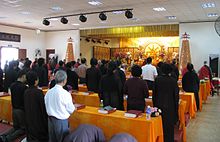
In Chinese Buddhism,lay Buddhist practitionershave traditionally played an important role, and lay practice of Buddhism has had similar tendencies to those of monastic Buddhism in China.[55]Many historical biographies of lay Buddhists are available, which give a clear picture of their practices and role in Chinese Buddhism. In addition to these numerous biographies, there are accounts from Jesuit missionaries, such asMatteo Ricci,which provide extensive and revealing accounts to the degree Buddhism penetrated elite and popular culture in China.[55]
Traditional practices such as meditation, mantra recitation, mindfulness of Amitābha Buddha, asceticism, and vegetarianism were all integrated into the belief systems of ordinary people.[55]It is known from accounts in the Ming dynasty that lay practitioners often engaged in practices from both the Pure Land and Chan traditions, as well as the study of the Buddhist sutras. TheHeart Sūtraand theDiamond Sūtrawere the most popular, followed by theLotus Sūtraand theAvatamsaka Sutra.[55]
Syncretism and multiple religious belonging
[edit]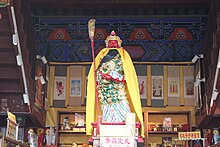
Chinese Buddhism also include influences from nativeChinese Religions,including Confucianism, Taoism, andChinese folk religion.[2]This ecumenical attitude and embrace of religious pluralism has been a common feature of Chinese culture since ancient times.[2]For example, Chinese Buddhists may practiceqigong,tai chi,andgongfu,venerate nativeChinese deities(likeGuan Yu,Mazu,andMonkey King), engage inancestor veneration,practicetraditional Chinese medicine,and make use ofFeng shuiandChinese talismans.Chinese religions like Taoism and Confucianism were also, in turn, influenced by Chinese Buddhism.[2]
The ancient idea of the compatibility of theThree Teachings(Confucianism, Buddhism, and Taoism) is common in China and is expressed in the phrasethethree teachings harmonious as one(TamGiáoHợpNhất;Sānjiào Héyī).[63][64]Chinese Buddhism developed Chinese mythologies and philosophies which incorporated and accommodated Chinese religions. For example, Chinese Buddhist apocryphal texts tell of howLaoziwas actually a disciple of the Buddha and also howConfuciuswas a bodhisattva.[8]Chinese Buddhist thinkers likeGuifeng Zongmiargued that all three teachings should be followed and practiced since they all contain important truths (though he also considered Buddhism to reveal the highest truth).[65]
One such important element of Chinese Buddhism are religious practices focused on one's ancestors, something that is shared in common with other traditional Chinese religions. This can include paying respect to them at various sites and at festivals like theQingmingandZhong Yuan Festival,as well as participating in services to pray for one's deceased ancestors.
The ritual burning of incense (shaoxiang,jingxiang) is another common religious practice in Buddhist spaces derived from traditional Chinese religion. During theZhou dynasty,the Chinese believed that smoke resulting from burning of sandalwood would act as a bridge between the human world and the spirits.[66]The practice remains a common offering in Chinese Buddhism, which it shared with other Chinese religions.
Another common feature of Chinese religion ismultiple religious belonging.As such, Chinese adherents may also practice Buddhism alongside other Chinese religious practices without seeing this as conflicting. According to Mario Poceski:
many or even most people who actually come to worship at Buddhist temples are not hardcore believers. A good number of them assume the kinds of fuzzy or hybrid religious identities that are typical of Chinese religiosity; among other things, that can mean that many of them also worship at Daoist temples or shrines associated with popular religion. This is one of the reasons why it is very difficult to arrive at reliable data about the number of "Buddhists" in China.[2]
During the Tang and Yuan dynasties, Chinese Buddhism was also in proximity to Chinese branches of theChurch of the East[67]andChristianityin general, and competed with these traditions,[68]especially in the Tang dynasty.[69]Chinese,[68]Tibetan,andMongolian Buddhism[70]were also significantly influenced by them[71]as Mongolian Buddhism, influenced by Nestorian beliefs[70]and Tibetan Buddhism, spread out during the Yuan dynasty. The three Buddhist traditions also heavily influenced each other at the time.
Traditions
[edit]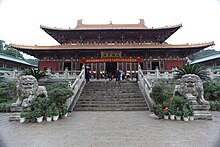

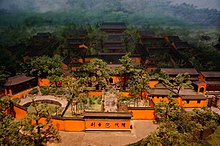

Major Chinese Buddhist traditions
[edit]Traditional Chinese Buddhist scholars likeSheng-yenenumerate thirteen Buddhist traditions or schools (Chinese:zōng).[72]This list is also found in traditional Japanese Buddhist histories, particularly that ofGyōnen(1240–1321).[73]
Over time, some of these schools survived or were revived as living traditions, while others are now defunct historical traditions or were absorbed into other schools. These "traditions" are not rigid designations and there has always been much intermixing, and many temples and communities are influenced by many of these traditions (and also by local Chinese custom and traditional Chinese religions like Taoism). Some traditions may also have numerous sub-schools or sects.[74]
The various Chinese Buddhist traditions are notexclusivist,and are better seen as trends, emphases,schools of thought,or "dharma-gates" ( pháp môn, fǎmén), instead of as separate sects.[23][75]Chün-fang Yü quotes a famous saying which describes the harmonious situation in Chinese Buddhism, "Tiantai and Huayan for doctrine, Chan and Pure Land for practice."[76]
As Mario Poceski notes, Chinese Buddhism "lacks clear [sectarian divisions of the kind we find in other Buddhist traditions".[2]All Chinese monastics follow the same ordination procedures and monastic precepts, and as such, there is no rigid separation between "schools" or "sects". While traditions like Chan and Tiantai are understood as distinctive teachings, they are all part of the single Chinese Buddhist tradition, which is "characterized by broad-minded acceptance of a variety of styles of discourse, modes of worship, and approaches to spiritual cultivation."[2]Due to Chinese Buddhism's acceptance of diversity,ecumenism,and difference, most Chinese Buddhists would not identify themselves as being part of a specific "school".[2]That being said, there are still disagreements and doctrinal debates within the community.[2]
The "thirteen schools" are:[72][77][78]
- TheChengshischool (historical), which focused on the study of theTattvasiddhi-Śāstra( "The Treatise that Accomplishes Reality"; Chinese: Thành thật luận,Chengshilun).
- The Kosa School ( câu xá tông ) (historical), based on the study ofAbhidharmausing theAbhidharmakośaofVasubandhu.
- The "Three Treatises" school( tam luận,Sānlùn,ChineseMadhyamaka), founded byKumarajiva(344–413 CE).
- ThePure Landschool
- The Nirvana school (historical), based on theMahāyāna Mahāparinirvāṇa Sūtratranslated byDharmarakṣa(c. 233–310); this was later absorbed into the Tiāntāi school.[77]
- The Dilun school (based on theDaśabhūmikā sutratranslated byBodhiruci); this was later absorbed into theHuayantradition.[77]
- The She lun school (based onAsanga'sSummary of the Mahayanatranslated byParamartha); it was later absorbed into theHuáyánand Consciousness-only schools.[77][72]
- The Consciousness Only school( duy thức tông;Wéishí,Yogācāra), a.k.a. Faxiang ( "dharma characteristics" ) school, founded by Xuanzang (602–664) and based on hisChengweishilun(The Demonstration of Consciousness-only).
- TheTiantaischool, also known as the Lotus school, due to their focus on theLotus Sutra.
- TheHuayanschool, the school of theAvatamsaka Sutra.
- TheVinayaschool or Nanshan school, a historical tradition which focused on theDharmaguptakamonastic discipline, established by the monkDaoxuan(596–667).[79]
- TheChan(Dhyana) school, i.e. theZentradition attributed to the founderBodhidharma,which focuses on sitting meditation (zuòchán) and developed numerous sub-schools likeCaodongandLinji.
- The Zhenyan school ( chân ngôn tông, "true word", "mantra"school), i.e.Chinese Esoteric Buddhism.Also calledMìjiao( mật giáo; Esoteric Teaching),Mìzōng( mật tông; "Esoteric Tradition" ), orTángmì( đường mật; "Tang Esoterica" ).
Many of these traditions were also later exported to other East Asian nations, like Japan, Korea, and Vietnam.
According toSheng-yen,the Chan school is the most popular school in China today, though this is often combined with Pure Land practice as well.[80]Sheng-yen also notes that the Tiantai, Huayan,Three Treatises,Consciousness Only,Vinaya, and Esoteric traditions are also present in modern Chinese Buddhism, though to a lesser extent.[80]
There is also a modernist movement calledHumanistic Buddhism,which emphasizeshumanism,charity,and other humanitarian practices that help improve social conditions.
New religious movements
[edit]There are many sects and organisations proclaiming a Buddhist identity and pursuit (foorfu:"awakening", "enlightenment" ) that are not recognised as legitimate Buddhism by theChinese Buddhist Associationand the government of the People's Republic of China. These groups include:
- GuanyinBuddhism [Awakening Teaching] (Quan âm phật giáoGuānyīn Fójiào) or Guanyin Church (Quan âm hộiGuānyīn Huì)[81]
- True Buddha School
- Buddhism [Awakening Teaching] of the Lord of Heaven of Infinite Thriving of the Mountain of Longevity (Thọ sơn vạn long thiên chủ phật giáoShòushān Wànlóng Tiānzhǔ Fójiào)
- Wulian Jingang Dadao ( "Great Way of the Innumerable Attendants of Awakening" )
- Hanmi Chinese esoteric Buddhism, Living Buddha Dechan Jueren
Holidays and festivals
[edit]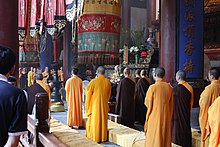


Chinese Buddhists celebrate numerous religious festivals and holidays and these are the most widely attended and popular Chinese Buddhist events.[82]
During religious festivals, Chinese people visit temples to take part in rituals, chanting, food, celebrations, parades, and to make offerings of prayers, incense, fruits, flowers, and donations. On such days, they may observe the moral precepts very strictly, as well as a full day's vegetarian diet. Some of the most important holidays celebrated by Chinese Buddhists include:Buddha's Birthday(on the eighth day of the fourth lunar month),Chinese New Yearand theLantern Festival(on the first and fifteenth days of the first lunar month), and theGhost Festival(fifteenth day of the seventh lunar month).[83]
List of Holidays
[edit]The following holiday dates given are based on the Chinese calendar, so that 8.4 means theEighth day of the fourth month in Chinese calendarand so on.[84]
- 8.12 — Enlightenment Day ofSakyamuniBuddha
- 1.1 — Birthday ofMaitreyaBuddha
- 9.1 — Birthday ofŚakra,Lord of theDevas
- 8.2 — Renunciation Day of Śākyamuni Buddha
- 15.2 —MahāparinirvāṇaDay of Śākyamuni Buddha
- 19.2 — Birthday of BodhisattvaAvalokiteśvara(Guan Yin)
- 21.2 — Birthday of BodhisattvaSamantabhadra
- 4.4 — Birthday of BodhisattvaManjusri
- 8.4 — Birthday of Śākyamuni Buddha
- 15.4 —Vesak
- 13.5 — Birthday of Bodhisattva Sangharama (Qie Lan)
- 3.6 — Birthday ofSkanda(Wei Tuo)
- 19.6 — Enlightenment Day of Bodhisattva Avalokiteśvara
- 13.7 — Birthday of BodhisattvaMahāsthāmaprāpta
- 15.7 — Ullambana FestivalGhost Festival
- 24.7 — Birthday of Bodhisattva Nagarjuna
- 30.7 — Birthday of BodhisattvaKṣitigarbha
- 22.8 — Birthday ofDīpaṃkaraBuddha (an ancient buddha)
- 19.9 — Renunciation Day of Bodhisattva Avalokiteśvara
- 30.9 — Birthday ofBhaiṣajyaguruBuddha (Medicine Buddha)
- 5.10 — Anniversary of the death ofBodhidharma
- 17.11 — Birthday of Amitabha Buddha
See also
[edit]| Part ofa serieson |
| Buddhism |
|---|
 |
- Avalokitesvara(Guanyin)
- Budai(Maitreya)
- Buddhism in Southeast Asia
- Buddhism in China
- Buddhism in Hong Kong
- Buddhism in Taiwan
- Buddhism and Eastern religions
- Chan Buddhism
- Chinese Buddhist canon
- Chinese Buddhist cuisine
- Chinese Esoteric Buddhism
- Chinese folk religion
- Dharma Drum Mountain
- East Asian Buddhism
- Fo Guang Shan
- Four Buddhist Persecutions in China
- Kṣitigarbha(Di Zang)
- List of Buddhist architecture in China
- List of converts to Buddhism
- Manjusri(Wen Shu)
- Samantabhadra(Pu Xian)
- Silk Road transmission of Buddhism
- Tiantai
- Persecution of Buddhists in the People's Republic of China
- Timeline of Buddhism
- Water and Land Ritual paintings
- Zhiyuan fabao kantong zong lu,a translation catalog
Notes
[edit]References
[edit]Citations
[edit]- ^abJiang Wu, "The Chinese Buddhist Canon" inThe Wiley Blackwell Companion to East and Inner Asian Buddhism,p. 299, Wiley-Blackwell (2014).
- ^abcdefghijklmnopqrstuvwxyzaaabacadaeafagahaiajakPoceski, Mario. "Chinese Buddhism" inThe Wiley-Blackwell Companion to Chinese Religions(pp. 197-218) edited Randall L. Nadeau. John Wiley & Sons, 2012.
- ^Chün-fang Yü (2020).Chinese Buddhism: A Thematic History,pp. 29–70. University of Hawaii Press
- ^abCook, Sarah (2017).The Battle for China's Spirit: Religious Revival, Repression, and Resistance under Xi Jinping.Archived2021-08-08 at theWayback MachineFreedom House Report. Rowman & Littlefield.
- ^"Six facts about Buddhism in China".Pew Research Center.2023-09-21.Retrieved2023-09-21.
- ^Acri, Andrea (20 December 2018)."Maritime Buddhism".Oxford Research Encyclopedia of Religion.Oxford:Oxford University Press.doi:10.1093/acrefore/9780199340378.013.638.ISBN978-0-19-934037-8.Archivedfrom the original on 19 February 2019.Retrieved30 May2021.
- ^Trung quốc văn hóa khoa mục nhận chứng chỉ nam.Hoa ngữ giáo học xuất bản xã.Sinolingua. 2010. p. 64.ISBN978-7-80200-985-1.
Công nguyên 1 thế kỷ ——— truyện nhập trung quốc nội địa, dữ hán văn hóa giao dung, hình thành hán truyện phật giáo.
- ^abChün-fang Yü (2020).Chinese Buddhism: A Thematic History,p. 14. University of Hawaii Press
- ^Maspero 1981, pp. 401-405.
- ^Chün-fang Yü (2020).Chinese Buddhism: A Thematic History,p. 15. University of Hawaii Press
- ^Maspero 1981, p. 409
- ^Williams, Paul.Mahāyāna Buddhism: The Doctrinal Foundations.2008. p. 30
- ^Chün-fang Yü (2020).Chinese Buddhism: A Thematic History,p. 18. University of Hawaii Press
- ^Warder, A.K.Indian Buddhism.2000. pp. 280–281
- ^Chün-fang Yü (2020).Chinese Buddhism: A Thematic History,p. 22. University of Hawaii Press
- ^Mair, Victor H.; Sanping Chen, Wood, Frances (2013).Chinese Lives: The People Who Made a Civilization,#28, Kumarajiva. Thames & Hudson.
- ^Fan Muyou.A Reexamination of the Influence of Kumārajīva's Thought on His Translation of the Vimalakīrtinirdeśa.The Eastern Buddhist 47/1: 57-80 ©2018 The Eastern Buddhist Society.
- ^Frankopan, Peter(March 2017).The Silk Roads: A New History of the World(First Vintage Books ed.). New York:Vintage Books.p. 32.ISBN978-1-101-94633-6.
- ^Chün-fang Yü (2020).Chinese Buddhism: A Thematic History,p. 76. University of Hawaii Press
- ^Radich, Michael.The Doctrine of *Amalavijnana in Paramartha (499-569), and Later Authors to Approximately 800 C.E.Archived2022-11-26 at theWayback MachineZinbun41:45-174 (2009) Copy BIBTEX
- ^Keng Ching and Michael Radich."Paramārtha."Brill's Encyclopedia of Buddhism. Volume II: LivesArchived2022-11-26 at theWayback Machine,edited by Jonathan A. Silk (editor-in chief), Richard Bowring, Vincent Eltschinger, and Michael Radich, 752-758. Leiden, Brill, 2019.
- ^Jerry Bentley,Old World Encounters: Cross-Cultural Contacts and Exchanges in Pre-Modern Times(New York: Oxford University Press, 1993), 81.
- ^ab"Living in the Chinese Cosmos | Asia for Educators".afe.easia.columbia.edu.Archivedfrom the original on 2021-04-16.Retrieved2022-12-01.
- ^Chua, Amy(2007).Day of Empire: How Hyperpowers Rise to Global Dominance–and Why They Fall(1st ed.). New York:Doubleday.p. 65.ISBN978-0-385-51284-8.OCLC123079516.
- ^Sullivan, Michael (2008).The Arts of China.Berkeley: University of California Press. p. 138.ISBN978-0-520-25569-2.
- ^Ebrey, Patricia (2003).The Cambridge Illustrated History of China.Cambridge: Cambridge University Press. pp. 116–117.ISBN0-521-43519-6.
- ^Rothschild, N, Henry (2015). Emperor Wu Zhao and Her Pantheon of Devis, Divinities, and Dynastic Mothers. Columbia UP. p. 221.
- ^Graeber, David (2011).Debt: The First 5000 Years.Brooklyn, NY: Melville House. pp.265–6.ISBN978-1-933633-86-2.
- ^Yampolski, Philip (2003), "Zen. A Historical Sketch", in Takeuchi Yoshinori (ed.), Buddhist Spirituality. Indian, Southeast Asian, Tibetan, Early Chinese, Delhi: Motilal Banarsidass
- ^McRae, John (2003),Seeing Through Zen,The University Press Group Ltd
- ^Dumoulin, Heinrich (2005),Zen Buddhism: A History. Volume 1: India and China, World Wisdom Books,pp. 256–257.ISBN978-0-941532-89-1
- ^abcNan Huai-Chin.Basic Buddhism: Exploring Buddhism and Zen.York Beach: Samuel Weiser. 1997. p. 99.
- ^Wu, Jiang (2008-04-01).Enlightenment in Dispute.Oxford University Press.doi:10.1093/acprof:oso/9780195333572.003.0003.ISBN978-0-19-533357-2.Archivedfrom the original on 2018-06-02.Retrieved2021-10-24.
- ^Ma, Yung-fen (2011).The Revival of Tiantai Buddhism in the Late Ming: On the Thought of Youxi Chuandeng (1554-1628) D81G0T8P(Thesis). Columbia University.doi:10.7916/d81g0t8p.
- ^Stanley Weinstein, "The Schools of Chinese Buddhism", in Kitagawa & Cummings (eds.),Buddhism and Asian History(New York: Macmillan 1987) pp. 257–265, 264.
- ^abcKeown, Damien.A Dictionary of Buddhism.2003. p. 104
- ^abMullin 2001, p. 358
- ^Chün-fang Yü.Chinese Buddhism: A Thematic History, University of Hawaii Press,pp. 240. 2020.
- ^abHuai-Chin, Nan (1999),Basic Buddhism. Exploring Buddhism and Zen,Mumbai: Jaico Publishing House
- ^Ji Zhe, Gareth Fisher, André Laliberté (2020).Buddhism after Mao: Negotiations, Continuities, and Reinventions,pp. 136-137. University of Hawaii Press.
- ^abYu, Dan Smyer. "Delayed contention with the Chinese Marxist scapegoat complex: re-membering Tibetan Buddhism in the PRC".The Tibet Journal,32.1 (2007)
- ^"murdoch edu".Archived fromthe originalon December 25, 2005.
- ^Lai 2003.
- ^"RELIGION-CHINA: Buddhism Enjoys A Revival".Inter Press Service.November 30, 2010.Archivedfrom the original on October 6, 2022.RetrievedOctober 6,2022.
- ^"Erica B. Mitchell (201),A Revival of Buddhism?".Archived fromthe originalon July 14, 2014.
- ^Hammerstrom, Erik J. (2020).The Huayan University Network: The Teaching and Practice of Avataṃsaka Buddhism in Twentieth-Century China.New York: Columbia University Press.ISBN978-0-231-55075-8.OCLC1154101063.
- ^Pei, Minxin(2023-12-31).The Sentinel State: Surveillance and the Survival of Dictatorship in China.Harvard University Press.doi:10.4159/9780674296459.ISBN978-0-674-29645-9.JSTORjj.10860939.OCLC1419055794.
- ^Madsen, Richard,ed. (2021-05-28), "The Sinicization of Buddhism and Its Competing Reinventions of Tradition",The Sinicization of Chinese Religions: From Above and Below,Brill,pp. 64–85,doi:10.1163/9789004465183_005,ISBN978-90-04-46517-6,S2CID242677252
- ^Joske, Alex(May 9, 2019)."Reorganizing the United Front Work Department: New Structures for a New Era of Diaspora and Religious Affairs Work".Jamestown Foundation.Retrieved2019-11-18.
- ^Chün-fang Yü (2020).Chinese Buddhism: A Thematic History,pp. 29-70. University of Hawaii Press
- ^Chün-fang Yü (2020).Chinese Buddhism: A Thematic History,p. 111. University of Hawaii Press
- ^abcdJones, Charles B. (2021).Pure Land: History, Tradition, and Practice,pp. 198-210. Shambhala Publications,ISBN978-1-61180-890-2.
- ^abJones, Charles B. (2021).Pure Land: History, Tradition, and Practice,pp. 188-198. Shambhala Publications,ISBN978-1-61180-890-2.
- ^abcHuaiyu Chen, "East Asian Transformations of Monasticism" inThe Wiley Blackwell Companion to East and Inner Asian Buddhism,p. 299, Wiley-Blackwell (2014).
- ^abcdefTwitchett, Denis, and Fairbank, John.The Cambridge History of China, Volume 8, Part 2.1998. p. 949
- ^Jiang, Wu (2008).Enlightenment in Dispute: The Reinvention of Chan Buddhism in Seventeenth-Century China:p. 146
- ^Kuan Ming.Popular Deities of Chinese BuddhismArchived2022-11-13 at theWayback Machine,Contemplative Order Malaysia.
- ^Chün-fang Yü (2020).Chinese Buddhism: A Thematic History,p. 72. University of Hawaii Press
- ^Chün-fang Yü (2020).Chinese Buddhism: A Thematic History,p. 71. University of Hawaii Press
- ^Chün-fang Yü (2020).Chinese Buddhism: A Thematic History,p. 121. University of Hawaii Press
- ^Szostak, Rick (2020-10-22).Making Sense of World History.London:Routledge.p. 321.doi:10.4324/9781003013518.ISBN978-1-003-01351-8.S2CID224902752.
- ^Chün-fang Yü (2020).Chinese Buddhism: A Thematic History,p. 125. University of Hawaii Press
- ^Vuong, Quan-Hoang (2018)."Cultural additivity: behavioural insights from the interaction of Confucianism, Buddhism and Taoism in folktales".Palgrave Communications.4(1): 143.doi:10.1057/s41599-018-0189-2.S2CID54444540.
- ^"Living in the Chinese Cosmos: Understanding Religion in Late-Imperial China".afe.easia.columbia.edu.Archivedfrom the original on 2017-05-08.Retrieved2022-11-30.
- ^Gregory, Peter N. (2002),Tsung-mi and the Sinification of Buddhism,University of Hawaiʻi Press, Kuroda Institute, p. 257. (originally published Princeton University Press, 1991, Princeton, N.J.),ISBN0-8248-2623-X
- ^Trung ương nghiên cứu viện võng trạm.Archivedfrom the original on 2020-04-05.Retrieved2016-01-29.
- ^Jenott, Lance (2002-05-07)."The Eastern (Nestorian) Church".Silk Road Seattle.University of Washington.Retrieved2023-03-01.
- ^abClasquin-Johnson, M. (December 2009)."The centuries-old dialogue between buddhism and christianity".Acta Theologica.29(2).ISSN1015-8758.Archivedfrom the original on 2020-07-09 – viaSciELO.
- ^Lau, Hua Teck (2003). "The Cross and the Lotus".Church and the Society.26(2): 85–87, 90, 93–94.
- ^abWillard Gurdon Oxtoby, ed. (2002).World Religions: Eastern Traditions(2nd ed.). Don Mills, Ontario:Oxford University Press.p. 434.ISBN0-19-541521-3.OCLC46661540.
- ^"Nestorians".McClintock and Strong Biblical Cyclopedia Online.StudyLamp Software.Retrieved2023-03-01.
- ^abcChan Master Sheng Yen (2007).Orthodox Chinese Buddhism: A Contemporary Chan Master's Answers to Common Questions,pp. 116-119. North Atlantic Books.
- ^Blum, Mark L. (2002).The Origins and Development of Pure Land Buddhism: A Study and Translation of Gyonen's Jodo Homon Genrusho,p. 15. Oxford University Press.
- ^"Buddhism in China Today: An Adaptable Present, a Hopeful Future".Archivedfrom the original on 2020-09-27.Retrieved2020-06-01..
- ^Jones, Charles B. (2019)Chinese Pure Land Buddhism, Understanding a Tradition of Practice,pp. 10-12. University of Hawaiʻi Press / Honolulu.
- ^Chün-fang Yü (2020).Chinese Buddhism: A Thematic History,p. 127. University of Hawaii Press
- ^abcdWilliam Edward Soothill, Lewis Hodous (1977).A Dictionary of Chinese Buddhist Terms: With Sanskrit and English Equivalents and a Sanskrit-Pali Index.p. 256. Motilal Banarsidass Publ.
- ^"Buddhist Schools: The Chinese Buddhist Schools".www.buddhanet.net.Archivedfrom the original on 2013-12-14.Retrieved2022-11-29.
- ^"Vinaya school".Oxford Reference.Archivedfrom the original on 2022-11-29.Retrieved2022-11-29.
- ^abChan Master Sheng Yen (2007).Orthodox Chinese Buddhism: A Contemporary Chan Master's Answers to Common Questions,pp. 118-119. North Atlantic Books.
- ^Munro & Spiegel (1994),p. 269–271.
- ^Chün-fang Yü (2020).Chinese Buddhism: A Thematic History,p. 97. University of Hawaii Press
- ^Chün-fang Yü (2020).Chinese Buddhism: A Thematic History,pp. 97-100. University of Hawaii Press
- ^"2020 Buddhist Calendar"(PDF).Archived(PDF)from the original on 2020-09-18.Retrieved2020-01-04.
Sources
[edit]- Broughton, Jeffrey L. (1999),The Bodhidharma Anthology: The Earliest Records of Zen,Berkeley, CA: University of California Press,ISBN978-0-520-21972-4
- Chen, Kenneth Kuan Sheng.Buddhism in China: A Historical Survey.Princeton, N.J., Princeton University Press, 1964.
- Dumoulin, Heinrich (2005),Zen Buddhism: A History,vol. 1:India and China,Bloomington, IN: World Wisdom,ISBN978-0-941532-89-1
- Han Yu.Sources of Chinese Tradition.c. 800.
- Ebrey, Patricia Buckley (1999),The Cambridge Illustrated History of China(paperback),Cambridge, England:Cambridge University Press,ISBN978-0-521-66991-7
- Ebrey, Patricia; Walthall, Anne; Palais, James (2006),East Asia: A Cultural, Social, and Political History,Boston, MA: Houghton Mifflin Company,ISBN978-0-618-13384-0
- Hill, John E. (2009)Through the Jade Gate to Rome: A Study of the Silk Routes during the Later Han Dynasty, 1st to 2nd Centuries CE.John E. Hill. BookSurge, Charleston, South Carolina.ISBN978-1-4392-2134-1.
- Hodus, Lewis (1923),Buddhism and Buddhists in China,archivedfrom the original on 2019-03-09,retrieved2013-03-29
- Kambe, Tstuomu (n.d.),Bodhidharma. A collection of stories from Chinese literature(PDF),archived fromthe original(PDF)on 2015-11-06,retrieved2013-02-19
{{citation}}:CS1 maint: year (link) - Lai, Hongyi Harry (2003),The Religious Revival in China. In: Copenhagen Journal of Asian Studies 18,archivedfrom the original on 2013-07-22,retrieved2013-03-29
- Laliberte, Andre (2011),Buddhist Revival under State Watch, in: Journal of Current Chinese Affairs, 40, 2,107-134,archivedfrom the original on 2019-12-25,retrieved2013-03-29
- Liebenthal, Walter.Chao Lun - The Treatises of Seng-ChaoHong Kong, China, Hong Kong University Press, 1968.
- Liebenthal, Walter.Was ist chinesischer BuddhismusAsiatische Studien: Zeitschrift der Schweizerischen Asiengesellschaft, 1952Was ist chinesischer BuddhismusArchived2016-03-06 at theWayback Machine
- McRae, John R. (2000),"The Antecedents of Encounter Dialogue in Chinese Ch'an Buddhism",in Heine, Steven; Wright, Dale S. (eds.),The Kōan: Texts and Contexts in Zen Buddhism,Oxford University Press,archivedfrom the original on 2012-07-25,retrieved2013-02-19
- McRae, John (2003),Seeing Through Zen,The University Press Group Ltd.
- Mullin, Glenn H.The Fourteen Dalai Lamas: A Sacred Legacy of Reincarnations(2001) Clear Light Publishers.ISBN1-57416-092-3.
- Saunders, Kenneth J. (1923). "Buddhism in China: A Historical Sketch",The Journal of Religion,Vol. 3.2, pp. 157–169; Vol. 3.3, pp. 256–275.
- Welch, Holmes.The Practice of Chinese Buddhism.Cambridge, Massachusetts: Harvard University Press, 1967.
- Welch, Holmes.The Buddhist Revival in China.Cambridge, Massachusetts: Harvard University Press, 1968.
- Welch, Holmes.Buddhism under Mao.Cambridge, Massachusetts: Harvard University Press, 1972.
- Welter, Albert (2000),Mahakasyapa's smile. Silent Transmission and the Kung-an (Koan) Tradition. In: Steven Heine and Dale S. Wright (eds.)(2000): "The Koan. Texts and Contexts in Zen Buddhism,Oxford, England: Oxford University Press
- Yang, Fenggang; Wei, Dedong,THE BAILIN BUDDHIST TEMPLE: THRIVING UNDER COMMUNISM(PDF),archived fromthe original(PDF)on June 6, 2010
- Yü, Chün-fang (2020),Chinese Buddhism: A Thematic History,Hawaii: University of Hawaii Press,ISBN978-0-8248-8348-5
- Zhu, Caifang (2003),Buddhism in China Today: The Example of the Bai Lin Chan Monastery. Perspectives, Volume 4, No.2, June 2003(PDF),archived fromthe original(PDF)on 2010-09-29
- Zvelebil, Kamil V. (1987), "The Sound of the One Hand",Journal of the American Oriental Society,107(1): 125–126,doi:10.2307/602960,JSTOR602960
Further reading
[edit]History
[edit]- Nan Huai-Chin (1998),Basic Buddhism: Exploring Buddhism and Zen,Translated by J.C. Cleary, Red Wheel Weiser
- Nan Huai-Chin (1995),The Story of Chinese Zen,Translated by Thomas Cleary, Charles E. Tuttle Company
- Tansen Sen (2003),Buddhism, Diplomacy, and Trade: The realignment of Sino-Indian Relations, 600–1400,Association for Asian Studies & University of Hawaiʻi Press
- Shinko Mochizuki, Leo M. Pruden, Trans. (1999). Pure Land Buddhism in China: A Doctrinal History, Chapter 1: A General Survey. In: Pacific World Journal, Third Series, Number 1, 91–103. Archived from theoriginal
- Shinko Mochizuki, Leo M. Pruden, Trans. (2001). Pure Land Buddhism in China: A Doctrinal History, Chapter 2: The Earliest Period; Chapter 3: Hui-yuan of Mt.Lu; and Chapter 4: The Translation of Texts-Spurious Scriptures. In: Pacific World Journal, Third Series, Number 3, 241–275. Archived from theoriginal
- Shinko Mochizuki, Leo M. Pruden, Trans. (2002). Pure Land Buddhism in China: A Doctrinal History, Chapter Five: The Early Pure Land Faith: Southern China, and Chapter Six: The Early Pure Land Faith: Northern China. In: Pacific World Journal, Third Series, Number 4, 259–279. Archived from theoriginal
- Shinko Mochizuki, Leo M. Pruden, Trans. (2000). Pure Land Buddhism in China: A Doctrinal History, Chapter 7: T'an-luan. In: Pacific World Journal, Third Series, Number 2, 149–165. Archived from theoriginal
First Buddhist revival
[edit]- Pittman, Don Alvin (2001),Toward a Modern Chinese Buddhism: Taixu's Reforms,University of Hawaii Press
- Daoru, Wei (n.d.),Buddhism in China and Modern Society: An Introduction Centering Around the Teachings of Taixu and Yinshun(PDF),archived fromthe original(PDF)on April 2, 2013
{{citation}}:CS1 maint: year (link) - Lancashire, Douglas (n.d.),Buddhism in Modern China(PDF)
{{citation}}:CS1 maint: year (link)
Contemporary Chinese Buddhism
[edit]- Chau, Adam Yuet (2010),Religion in Contemporary China: Revitalization and Innovation,Taylor & Francis
- Miller, James (2006),Chinese Religions in Contemporary Societies,ABC-CLIO
- Baumer, Christoph (2011),China's Holy Mountain: An Illustrated Journey into the Heart of Buddhism,London: I.B.Tauris,ISBN978-1-84885-700-1
- Master Sheng Yen (2007),Orthodox Chinese Buddhism,Translated by Douglas Gildow and Otto Chang, North Atlantic Books
- Munro, Robin; Spiegel, Mickey (1994).Detained in China and Tibet: A Directory of Political and Religious Prisoners.Human Rights Watch.ISBN978-1-56432-105-3.
- List first published in:"Appendix: Sects and Societies Recently or Currently Active in the PRC".Chinese Sociology & Anthropology.21(4): 103–104. 1989.doi:10.2753/CSA0009-46252104102.




